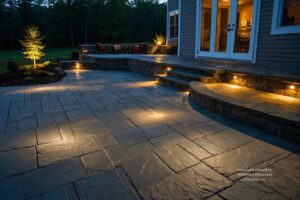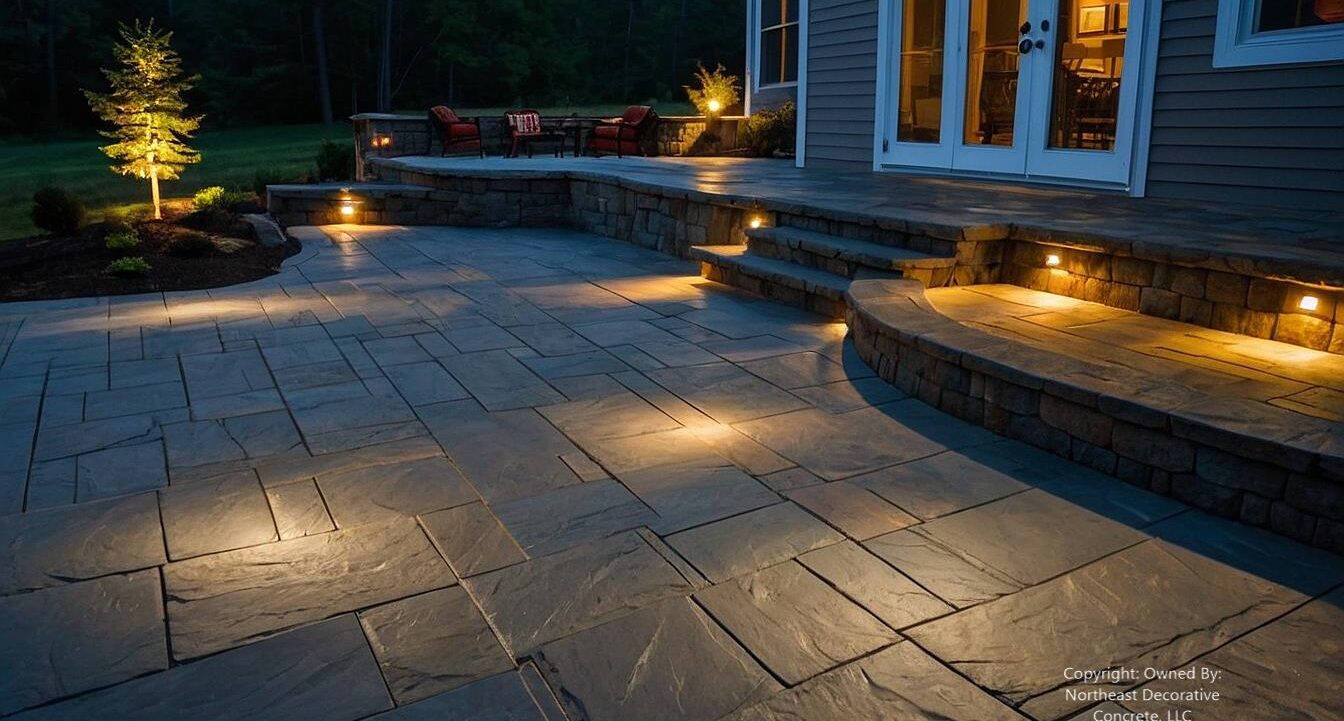
Recommended Tools for Applying Stamped Concrete Sealer
Stamped concrete makes driveways, patios, and pool decks look nice. But after rain, it can turn into a slippery ice rink. The secret to keeping it safe and beautiful? High-quality sealer applied with the right tools. This guide shows you the tools that pros trust, how to use them, and why cutting corners can ruin your project.
Why Proper Tools Matter for Stamped Concrete Sealers
Imagine spending $6,000 on a stamped concrete patio, only to see it fade or turn slippery within months. Poor tool choices are often the culprit. The right tools ensure:
-
Even sealer coverage.
-
Long-lasting protection against stains and weather.
-
Enhanced color and texture.
-
Reduced risk of slips.
Let’s break down the must-have tools, from prep to final application method touches.

Preparation Tools: Setting the Stage for Success
Tools Needed:
| Tool | Key Specifications | Purpose | Recommended Brands/Models | Application Notes |
|---|---|---|---|---|
| Pressure Washer | 3,000–4,000 PSI, 15° nozzle tip | Removes dirt, old sealer, and mildew from stamped patterns | Ryobi RY142300, Simpson Cleaning MegaShot | Use before reapplying sealer to ensure adhesion; avoid >25° tips to prevent texture damage. |
| Stiff-Bristle Scrub Brush | Acid-resistant polypropylene bristles | Scrubs chemical strippers (e.g., Soy Gel) into old sealer for removal | Libman 6” Grout Brush, Purdy 6” Scrub Brush | Pair with strippers for epoxy or acrylic buildup; avoid wire brushes to prevent scratching. |
| Sprayer | – Pump-up: Stainless steel (solvent-based) – Airless: 0.015–0.021” nozzle |
Applies solvent- or water-based sealers evenly | Chapin Xtreme (solvent), Graco Ultra (airless) | Use pump-up dispensers for <35% solids sealers; airless for high-viscosity products. |
| Back-Rolling Roller | 3/8”–3/4” nap, solvent-resistant lambswool or microfiber | Pushes sealer into stamp grooves and eliminates puddles | Wooster Pro 18” Roller, Purdy 3/8” Nap | Follow spray application immediately; redistribute sealer for uniform coverage. |
| Respirator | NIOSH-approved with organic vapor cartridges (e.g., 3M 6001) | Protects against xylene, acetone, and solvent fumes | 3M Multi-Gas Respirator, Honeywell North 7700 | Mandatory for solvent sealers; replace cartridges every 40 hours. |
| Mixing Drill & Paddle | ½” chuck, stainless steel paddle | Blends anti-slip additives (e.g., Shark Grip) into sealer without coagulation | DEWALT DCD791D2 Drill, Walthers Mixer Attachment | Mix 300–500 RPM to avoid air bubbles; clean with xylene post-use. |
Before applying sealer, your concrete must be clean, dry, and free of old sealant.
1. Pressure Washer
Best for: Removing dirt, mildew, and old sealers.
-
Recommended PSI: 3,000–4,000
-
Pro Tip: Use a 15°–25° nozzle tip to avoid damaging the stamped pattern.
-
A homeowner brought new life to their 10-year-old patio using a Ryobi 3,200 PSI washer and chose a sealer surface cleaner attachment.
2. Concrete Spray Cleaners and Strippers
Best for: Tackling oil stains or stubborn sealer residue.
-
Top Picks:
-
Soy Gel (eco-friendly)
-
Xylene (for solvent sealers)
-
-
Safety Note: Wear gloves and goggles—xylene fumes are strong!
3. Stiff-Bristle Brooms and Scrub Brushes
Best for: Scrubbing release agent residue from stamp grooves.
| Tool | Use Case | Brand Example |
|---|---|---|
| Pressure Washer | Deep cleaning | Ryobi RY142300 |
| Scrub Brush | Removing powdered release | Libman 6” Grout Brush |
Application Tools: Getting the Job Done Right
1. Concrete Sprayers: The Heart of Sealer Application
Resin dispensers ensure thin, even seal coats—critical for avoiding bubbles or peeling.
| Type | Pros | Cons | Best For |
|---|---|---|---|
| Pump-Up | Affordable, easy-to-clean | Manual pumping required | Small areas |
| Airless | Fast, professional finish | Expensive, overkill for DIY | Large driveways |
| HVLP | Lightweight, minimal overspray | Requires compressor | Detailed stamp patterns |
Pro Tip: Mix 5–10% xylene with the first coat to reactivate old sealer layers.
2. Rollers and Backer Pads
Best for: Working sealer into textured grooves.
-
Nap Length: 3/8”–1/2” for a stamped concrete nap.
-
Material: Solvent-resistant lambs wool or microfiber.
A contractor in Goffstown uses a Wooster 18” roller with a 3/8” nap for pool decks. Then, they back-roll to stop puddling.
3. Anti-Slip Additive Applicators
Best for: Mixing traction additives, like Shark Grip, into the sealer.
-
Tool: Paint mixer attachment for drills
-
Ratio: 1–2 lbs of additive per gallon of sealer

Safety Gear: Non-Negotiable Decorative Concrete Seal Protection
Concrete sealers contain harsh chemicals. Protect yourself with:
-
Respirator: 3M Multi-Gas Cartridge (blocks xylene fumes).
-
Gloves: Nitrile-coated for grip and chemical resistance.
-
Goggles: Anti-fog, wraparound style.
A DIYer in Exeter ended up in the ER after inhaling sealer fumes without a mask.
Maintenance Tools: Keeping Your Sealer Fresh
Reseal every 3–5 years with:
-
Soft-Wash System: This is for gentle cleaning without stripping the sealer.
-
Squeegee: Removes standing water to prevent mildew.
-
Sealer Touch-Up Kit: Includes mini rollers and brushes for minor repairs.
How a Homeowner Saved Their Slippery Driveway
Problem: A Salem, NH, user’s stamped driveway turned dangerously slick after the rain.
Solution:
-
Pressure-washed with a Ryobi 3,200 PSI washer.
-
Two Foundation Armor AR350 sealer coats were applied using a Chapin pump dispenser.
-
Shark Grip additive was added to the second coat.
Result: The driveway regained color highlights and traction, surviving two winters without reapplication.
Pro Tips From the Trenches
-
Weather Matters: Apply sealer when temps are 50–90°F and humidity is below 70%.
-
Thin Coats Win: Two thin coats are better than one thick coat.
-
Test First: Spread a small area to check for compatibility with the old sealer.
Common Mistakes to Avoid
-
Using the Wrong Roller: A 1/4” nap won’t reach stamp grooves.
-
Skipping Back-Rolling: Spraying alone leaves uneven coverage.
-
Ignoring Drying Time: Wait 24 hours between coats.
Final Thoughts: Invest in Quality Tools
A $50 sprayer might save money upfront, but a $150 airless model ensures a decade of protection. Whether rolling or spraying sealer onto a patio or a driveway, the right tools make all the difference.
“Sealing stamped concrete is like creating art. You need the right tools and brushes.”
Grab those tools and give your stamped concrete the VIP treatment it deserves!
Frequently Asked Questions:
Q: What sprayer specifications are required for solvent-based sealers with >35% solids?
A: Solvent sealers like Calico Stamped Concrete Sealer (38% solids) need airless sprayers or HVLP systems. These tools can manage their thick, breathable viscosity. Pump-up dispensers are only suitable for sealers with less than 35% solids. Proline’s 600 VOC sealer needs stainless steel nozzles, which help stop corrosion.
Q: Why is a 3/8” nap roller critical for stamped concrete sealer application?
A: Stamped concrete has recessed patterns, such as cobblestone or slate. These need rollers with a nap between 3/8” and 1/2”. These rollers help push the sealer into the grooves. Thin-nap rollers (1/4”) can’t reach textures deeper than 1/8”, leading to uneven coverage and faster wear. Back-rolling with a lambswool roller (e.g., Wooster 18” Pro) eliminates puddling in low spots.
Q: How do I prevent sealer degradation when using anti-slip additives?
A: You need solvent-resistant drill attachments to mix additives like Shark Grip resin. Use something like a stainless steel paint mixer. This helps prevent chemical reactions. You should mix 1 to 2 pounds per gallon. Silicone-based additives can coagulate if stirred with non-coated tools, causing uneven dispersion. Post-application, flush sprayers with xylene to remove abrasive particles.
Q: What sprayer PSI range avoids over-application on stamped surfaces?
A:
| Sealer Base | PSI Range | Nozzle Tip |
|---|---|---|
| Solvent-based | 800–1,200 | 0.015–0.021” |
| Water-based | 500–800 | 0.017–0.023” |
| Exceeding 1,500 PSI with airless sprayers (e.g., Graco Ultra) can force sealer into pores, causing blistering during temperature swings. |
Q: Which tools are essential for removing old sealer before reapplication?
A:
Stripping degraded sealer requires:
-
Diamond grinders (e.g., Husqvarna PG 680) for thick epoxy layers.
-
Chemical strippers (e.g., Soy Gel) are applied with acid-resistant polypropylene brushes.
-
Pressure washers (3,000–4,000 PSI, 15° tip) to clear residue. Skip wire brushes. They scratch stamped patterns and raise resealing costs by 20%–30%.
Our Locations:
Nashua, NH
North Hampton, NH
Concord, NH

